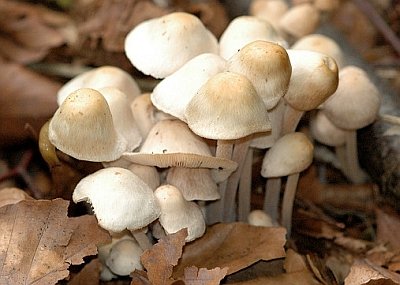The clustered toughshank mushroom, Gymnopus confluens (Pers.) Antonín, Halling & Noordel.
Classification
Kingdom Fungi
Phylum Basidiomycota
Class Basidiomycetes
Order Agaricales
Family Tricholomataceae
Genus Gymnopus
Synonyms
Agaricus archyropus Pers.
Mycol. eur. (Erlanga) 3: 135 (1828)
Agaricus confluens Pers.
Observ. mycol. (Lipsiae) 1: 8 (1796)
Agaricus ingratus Schumach.
Enum. pl. (Kjbenhavn) 2: 304 (1803)
Collybia confluens (Pers.) P. Kumm.
Führ. Pilzk. (Zwickau): 117 (1871)
Collybia ingrata (Schumach.) Quél.
Mém. Soc. Émul. Montbéliard, Sér. 2 5: 318 (1872)
Marasmius archyropus (Pers.) Fr.
Epicr. syst. mycol. (Upsaliae): 378 (1838)
Marasmius confluens (Pers.) P. Karst.
Kritisk Öfversigt af Finlands Basidsvampar, Tillägg: 102 (1889)
Marasmius hariolorum sensu Rea (1922)
fide Checklist of Basidiomycota of Great Britain and Ireland (2005)
Common names
Clustered toughshank
Tufted collybia/gymnopus
Knippe-fladhat (Danish)
Description
Cap: 2-5 cm diameter, convex with an involute margin at first, becoming broadly convex to nearly flat, sometimes with a low or sunken umbo; pale brown to reddish brown, fading to pale pinkish buff or whitish; surface glabrous, hygrophanous, slightly striate when moist; flesh thin flexible, white.
Gills: adnate to adnexed or nearly free, thin, narrow, close or crowded; cream colored.

Stem: 4-10 cm long, 0.2-0.6 cm thick; slender, cylindrical to compressed, equal or slightly larger near base, tough, elastic, hollow; surface dry, covered with grayish hairs, reddish brown underneath.
Spores: 7-9 x 3.5-4 µm elliptical, smooth, entire, hyaline, non-amyloid.
Spore print: white.
Habitat: gregarious or caespitose, often clustered, sometimes in fairy rings or arcs on the ground among fallen leaves near hardwoods or conifers; saprobic; summer-fall; common.
Odor: ‘cyanic’ (Heinemann, 1942).
Edibility: the sources I’ve seen say it’s edible if the tough stalks are removed. Known to contain HCN (Heinemann, 1942).
Medicinal properties
Antitumor effects
Polysaccharides extracted from the mycelial culture of G. confluens and administered intraperitoneally into white mice at a dosage of 300 mg/kg inhibited the growth of Sarcoma 180 and Ehrlich solid cancers by 70% and 80%, respectively (Ohtsuka et al., 1973).

My name is Austin Collins.
I've dedicated my life to Mushrooms.
I believe Mushrooms are the best kept secret when it comes to health and well being.
For that reason, I would like to share a company with you that in my opinion makes the best mushroom products on the market.
The company is called Noomadic Herbals, my favorite supplement they make is called "Mushroom Total".
I take their products every day and they have helped me think better and have more energy. Give them a try.
-Austin
Links
New York Botanical Gardens website
Fungi of Poland
References
Antonín V, Halling RE, Noordeloos ME.
Generic concepts within the groups of Marasmius and Collybia sensu lato.
Mycotaxon. 1997 63:359-68.
Heinemann P.
Observations sur les Basidio-mycetes a acide cyanhydrique.
Bull Trimestr Soc Mycol France. 1942 58(1/2):99-104.
Herrera T, Perez-Silva E, Valenzuela VH.
New contribution to the knowledge of the macromycetes of the ecological reserve of the pedregal of San Angel, DF, Mexico.
[Nueva contribucion al conocimiento de los macromicetos de la Reserva Ecologica del Pedregal de San Angel, D.F., Mexico]
Revista Mexicana de Biodiversidad. 2006 77(1):51-7.
Ohtsuka S, Ueno S, Yoshikumi C, Hirose F, Ohmura Y, Wada T, Fujii T, Takahashi E.
Polysaccharides having an anticarcinogenic effect and a method of producing them from species of Basidiomycetes.
UK Patent 1331513, 26 September 1973.



